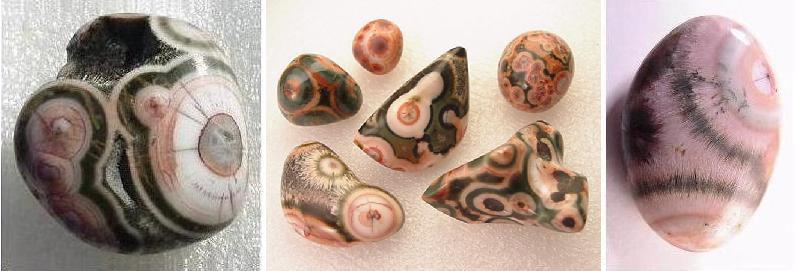( Fr- thomsonite; Ger- Thomsonit;
Nor- thomsonitt; Rus- ![]() )
)
THOMSONITE, NaCa2Al5Si5O20·6H2O.

A. Thomsonite. Polished piece ("diameter" - 2.6 cm) extacted from a basalt outcrop about five miles south of Grand Marias, Minnesota. (© photo by John Truax, www.mylittlerockshop.com)
B. Thomsonite. Polished pieces ("diameter" of spheroid on upper right - 1.4 cm) extacted from a basalt outcrop about five miles south of Grand Marias, Minnesota. (© photo by John Truax, www.mylittlerockshop.com)
C. Thomsonite. Polished piece (greater axis -1.4 cm) extacted from a basalt outcrop about five miles south of Grand Marias, Minnesota. (© photo by John Truax, www.mylittlerockshop.com)
DESCRIPTION: Thomsonite is one of the zeolite minerals. The following
properties are for the variety of
thomsonite that is most often utilized in the fashioning of
gemstones.
Colors - pink, reddish, purplish, yellowish,
green, brown, tan, off-white, and nearly black, typically comprising
concentric rings, sometimes referred to as eyelike masses
H. 5-5½
S.G. 2.10 - 2.40
Light transmission - translucent
Luster -
pearly to subvitreous
Miscellany - rarely chatoyant; consists
of compact spheroidal masses made up of radiating
fibers.
OTHER NAMES: The following names (listed alphabetically) are given as discredited
synonyms for thomsonite by the Commission
on New Minerals and Mineral Names of the International Mineralogical
Association: bagotite, carphostilbite, comptonite, faröelite, gibsonite, karphostilbite,
koodilite, lintonite,
mesole, mesolitine,
metathomsonite, ozarkite,
picrothomsonite, scoulerite, sphaerodesmine, sphaerostilbite, strontium
thomsonite, tonsonite, triploclase,
triploklase and winchellite.
All are noted here even though several of them have never been applied
to the gemrock variety described in this entry. Those I have seen
applied to the gemrock variety are underlined in the just listed
discredited synonyms and are also on the following list:
NOTEWORTHY LOCALITIES: near Grand Marais,
Cook County, Minnesota; on Isle
Royale National Park, and nearby Keweenawan
Peninsula, Michigan; on Michipicotin Island, Ontario; and sporadically at other localities
along or near the western part of Lake Superior. Although several
non North American localities have been alluded to in the literature --
e.g., Breiddalsheidi,
Iceland; Saxony,
Germany; Italy; and the Faroe Islands -- I have been unable to
determine whether the thomsonite from these localities was or was not
of the gemrock variety.
Most thomsonite nodules and their derived pebbles are less than 0.6 cm (~ 1/4 inch) in greatest dimension -- i.e., those illustrated are larger than the average. And, those enclosed in basalt are extremely difficult to remove without breaking them. Consequently, a very large percentage of those used as gemstones have been, and continue to be, pebbles collected from gravels. These days, many are recovered off-shore by scuba divers.
Thomsonite nodules have been found in
Alaskan
Eskimo burial sites over 2,000 years old. Russians are said to
have made
jewelry
including thomsonite during the 8th century. Queen Victoria commissioned
the Chippewa Indians to mine Grand Marais (Minnesota) thomsonites
because the
nodules
were becoming scarce in Scotland. (Weaver,
2002)
SIMULANT: Prehnite with native copper inclusions -- see last paragraph under the REMARKS subheading. [ I used a petrographic microscope and/or x-ray diffractometer to distinguish the prehnite from thomsonite.].
REFERENCE: Huber, 1983.
R. V. Dietrich © 2015
Last
update: 14 July 2005
web page created by Emmett Mason